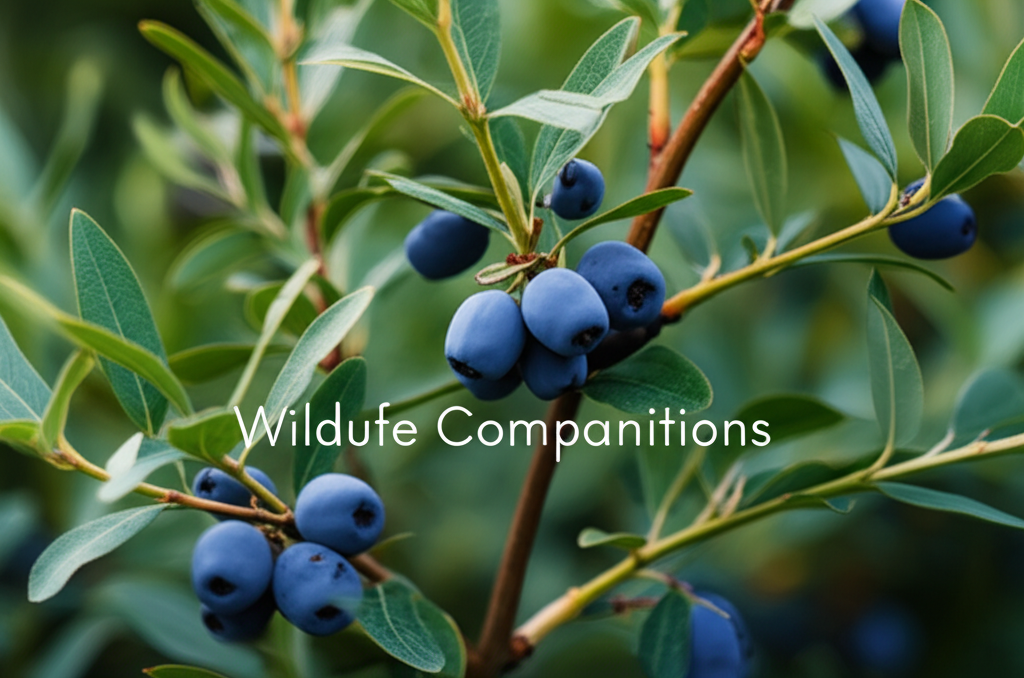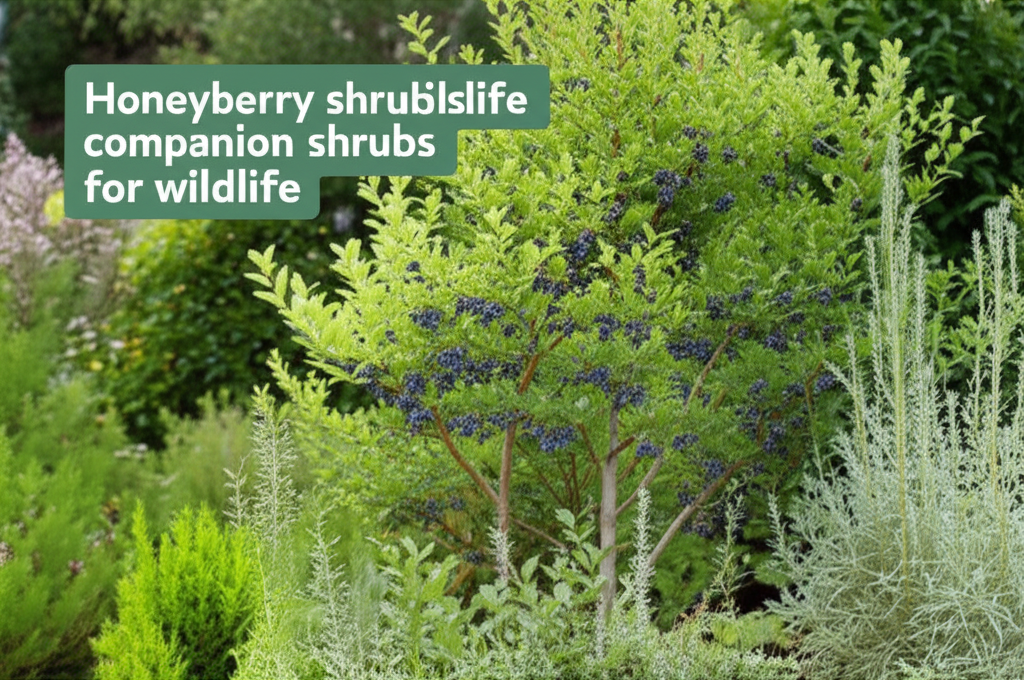The Allure of the Honeyberry Shrub
The honeyberry shrub (Lonicera caerulea), also known as haskap, has rapidly gained popularity among gardeners and wildlife enthusiasts alike. This hardy, adaptable shrub offers a unique combination of edible berries, early spring blooms, and a generous contribution to local ecosystems. Its versatility makes it an excellent cornerstone for a wildlife-friendly garden, but its true potential is unlocked through thoughtful companion planting. By strategically selecting complementary shrubs, you can create a layered, diverse habitat that supports a wider array of beneficial insects, birds, and other small creatures throughout the year.
Why Companion Planting for Wildlife?

Companion planting is more than just aesthetics; it’s a holistic approach to garden design that fosters a balanced and resilient ecosystem. For wildlife, this means providing a continuous buffet of food sources, diverse shelter options, and safe breeding grounds. By pairing honeyberry with other shrubs, we aim to:
- Extend the Blooming Season: Different plants bloom at different times, offering a staggered supply of nectar and pollen for pollinators.
- Provide Varied Food Sources: Beyond honeyberry’s delicious fruit, companion shrubs can offer seeds, nuts, berries, and attract insects that serve as food for birds and other animals.
- Offer Diverse Shelter and Nesting Sites: Different plant structures – from dense foliage to thorny branches – cater to the specific needs of various wildlife.
- Enhance Soil Health: Certain companion plants can improve soil structure and nutrient availability, benefiting all plants in the vicinity.
- Natural Pest Control: Some companions attract predatory insects that can help manage garden pests.
Key Honeyberry Facts for Companion Planting
Understanding the needs and characteristics of the honeyberry shrub is crucial for selecting the right companions.
| Characteristic | Honeyberry Shrub (Lonicera caerulea) |
|---|---|
| Bloom Time | Early spring (late March to May, depending on climate) |
| Pollination Needs | Cross-pollination required; needs at least two different varieties planted nearby. |
| Sunlight Requirements | Full sun to partial shade |
| Soil Preferences | Prefers well-drained, slightly acidic to neutral soil (pH 5.5-7.0). Tolerates a range of soil types. |
| Water Needs | Moderately drought-tolerant once established, but benefits from consistent moisture, especially during fruiting. |
| Mature Size | Typically 4-6 feet tall and wide, though some varieties can reach up to 8 feet. |
| Wildlife Appeal | Nectar/pollen for early pollinators, berries for birds and small mammals. |
Top Companion Shrubs for a Honeyberry Habitat
When choosing companions, consider their growth habits, bloom times, and the specific wildlife you wish to attract. The goal is to create a symbiotic relationship where each plant enhances the environment for the other and for the wildlife it supports.
Shrubs for Early Spring Pollinators and Bloom
Since honeyberry blooms very early, supporting the pollinators that emerge at this time is paramount.
Serviceberry (Amelanchier spp.)
Serviceberry is an exceptional companion, often blooming concurrently or just before honeyberry. Its delicate white flowers provide an early nectar and pollen source for a wide range of native bees, butterflies, and other beneficial insects.
- Wildlife Benefits: Early nectar/pollen, edible berries in early summer for birds and humans, provides nesting sites and shelter.
- Growing Conditions: Prefers full sun to partial shade and well-drained soil. Tolerates a variety of soil pH.
- Growth Habit: Can be grown as a large shrub or small tree, often multi-stemmed.
Forsythia (Forsythia spp.)
While not offering edible fruit, forsythia’s vibrant yellow blooms are a beacon for early-emerging pollinators. Its abundant flowers provide a significant pollen source.
- Wildlife Benefits: Early nectar/pollen for bees and other insects.
- Growing Conditions: Tolerant of most soil types and conditions, prefers full sun for best flowering.
- Growth Habit: Fast-growing, arching shrub, can be pruned to manage size.
Shrubs for Summer and Fall Berry Producers
A succession of berry production throughout the season ensures a consistent food source for birds and small mammals.
Elderberry (Sambucus spp.)
Elderberry is a powerhouse for wildlife. Its large clusters of flowers attract pollinators, and its dark purple berries are a favorite for many bird species, ripening after honeyberries.
- Wildlife Benefits: Nectar/pollen for pollinators, abundant berries for birds (robins, thrushes, cardinals), attracts beneficial insects, provides dense cover.
- Growing Conditions: Prefers full sun to partial shade and moist, well-drained soil. Tolerates a range of soil types.
- Growth Habit: Fast-growing, large shrub, can become quite wide.
Highbush Blueberry (Vaccinium corymbosum)
If your soil is acidic (which honeyberry also appreciates), blueberries are a fantastic addition. Their flowers are attractive to bees, and the fruit is a prized food for birds.
- Wildlife Benefits: Nectar for bees, delicious berries for birds and small mammals.
- Growing Conditions: Requires acidic soil (pH 4.5-5.5), full sun, and consistent moisture.
- Growth Habit: Upright shrub, typically 5-8 feet tall.
Chokeberry (Aronia spp.)
Chokeberries offer beautiful spring flowers, attractive foliage, and very persistent berries that persist into winter, providing a crucial food source when other options are scarce.
- Wildlife Benefits: Pollen/nectar, persistent berries for birds and small mammals, good fall color, offers shelter.
- Growing Conditions: Very adaptable to soil types and moisture levels, tolerates full sun to partial shade.
- Growth Habit: Upright, spreading shrub, typically 3-6 feet tall.
Shrubs for Shelter and Nesting
Dense foliage and sturdy branches provide vital protection and nesting opportunities.
Ninebark (Physocarpus opulifolius)
Ninebark offers layered benefits. Its spring flowers attract insects, its foliage provides cover, and its exfoliating bark can even offer habitat for overwintering insects.
- Wildlife Benefits: Nectar/pollen for pollinators, dense foliage for nesting and shelter, seeds for finches, unique bark structure for insects.
- Growing Conditions: Highly adaptable, tolerates full sun to partial shade and a wide range of soil conditions.
- Growth Habit: Upright, rounded shrub, 5-8 feet tall and wide.
Viburnum (Viburnum spp.)
Many viburnum species are excellent for wildlife, offering a variety of bloom times, attractive fruit, and sturdy branching structures for nesting. Examples include Arrowwood Viburnum (Viburnum dentatum) and American Cranberrybush Viburnum (Viburnum trilobum).
- Wildlife Benefits: Nectar/pollen for pollinators, berries enjoyed by many bird species, sturdy branches for nesting, provides excellent cover.
- Growing Conditions: Generally adaptable to full sun to partial shade and various soil types.
- Growth Habit: Varies by species, but generally medium to large shrubs.
Dogwood (Cornus spp.)
Certain native dogwoods, like Red Osier Dogwood (Cornus sericea), offer attractive spring flowers, berries, and striking winter stem color. Their dense growth habit is excellent for shelter.
- Wildlife Benefits: Nectar/pollen, berries for birds, dense cover, attractive winter stems.
- Growing Conditions: Prefers moist, well-drained soil, tolerates full sun to partial shade.
- Growth Habit: Spreading shrub, often suckering, 5-9 feet tall.
Creating Your Honeyberry Habitat: A Step-by-Step Approach
Designing a wildlife-friendly garden is an iterative process, but here’s a framework to get you started.
Step-by-Step Guide to Companion Planting
- Assess Your Site: Evaluate sunlight, soil type, and moisture levels in your honeyberry planting area.
- Choose Your Honeyberry Varieties: Ensure you have at least two different honeyberry cultivars for successful cross-pollination.
- Select Companions Based on Needs: Pick shrubs that complement honeyberry’s bloom time, provide successive fruit crops, and offer diverse habitat features. Aim for variety.
- Consider Growth Habits: Place taller shrubs behind shorter ones and consider how their mature sizes will interact. Avoid overcrowding.
- Plant for Succession: Aim to have something blooming or fruiting from early spring through late fall.
- Incorporate Native Plants: Prioritize native species, as they are often best adapted to local conditions and support the most native wildlife.
- Add Groundcover and Perennials: While focusing on shrubs, remember that lower-growing plants, wildflowers, and grasses also contribute significantly to habitat diversity.
- Provide Water: A shallow water source, like a bird bath or a small pond, will dramatically increase the attractiveness of your habitat.
- Avoid Pesticides: Embrace natural pest control methods to ensure the safety of all visiting wildlife.
Pros and Cons of Honeyberry Companion Planting for Wildlife
Like any gardening strategy, companion planting has its advantages and disadvantages.
| Pros | Cons |
|---|---|
| Enhanced Biodiversity: Supports a wider range of pollinators, birds, and beneficial insects. | Potential for Competition: Overcrowding can lead to competition for water, nutrients, and sunlight. Careful spacing is crucial. |
| Extended Food Sources: Provides continuous food from spring blooms to persistent fall/winter berries. | Increased Maintenance: More plants mean more watering, weeding, and pruning, especially when establishing. |
| Improved Habitat Structure: Offers diverse shelter, nesting sites, and protection. | Disease and Pest Transmission: Some companion plants might attract pests or diseases that could affect honeyberry. Research is key. |
| Aesthetic Appeal: Creates a visually rich and dynamic garden display throughout the seasons. | Soil pH Considerations: While honeyberry is somewhat adaptable, specific companions might have stricter pH requirements that need careful management. |
| Reduced Need for Inputs: A healthy ecosystem can reduce the need for fertilizers and pesticides. | Space Requirements: Different shrubs have varying mature sizes, requiring adequate space to grow without hindering each other. |
Beyond Shrubs: Enhancing Your Wildlife Habitat
While shrubs form the backbone of your honeyberry habitat, consider incorporating other elements to maximize its ecological value.
Groundcovers and Understory Plants
Low-growing plants provide crucial habitat and food for smaller creatures.
- Wild Strawberries (Fragaria virginiana): Offer early spring flowers for pollinators and small, edible fruits.
- Clover (Trifolium spp.): Fixes nitrogen in the soil and provides nectar for bees and butterflies.
- Native Ferns: Offer shade and moisture, providing habitat for insects and amphibians.
The Importance of Water
A water source is often the single most impactful addition to any wildlife garden. A shallow dish of water with pebbles or a small pond will attract birds, insects, and even beneficial amphibians.
Seasonal Interest and Wildlife Appeal
Think about the entire year when planning your companions.
- Spring: Honeyberry, Serviceberry, Forsythia, Redbud (small tree).
- Summer: Elderberry, Blueberry, Ninebark, Coneflower (perennial).
- Fall: Chokeberry, Viburnum, Dogwood, Asters (perennial).
- Winter: Persistent berries (Chokeberry, Viburnum), attractive bark (Dogwood), seed heads (perennials).
Conclusion: A Living Tapestry for Nature
By thoughtfully selecting companion shrubs for your honeyberry planting, you’re not just creating a productive edible garden; you’re cultivating a vibrant, self-sustaining ecosystem. Each carefully chosen shrub contributes to a larger tapestry of life, offering food, shelter, and nesting sites for a diverse array of wildlife. Witnessing the buzz of pollinators on your honeyberry blossoms, the flit of birds to your elderberry clusters, and the general hum of life in your garden is a profoundly rewarding experience, a testament to the power of intentional, nature-inspired gardening. Embrace the interconnectedness, and watch your garden transform into a true haven for both you and your wild neighbors.


